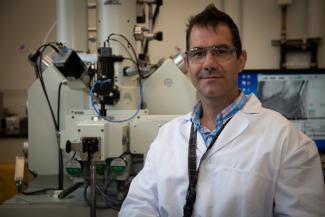NETL geologist Scott Montross presented at one of the world’s leading research conferences focused on carbon and coal-to-products research where he joined leading carbon and material scientists and two U.S. senators from the Senate Committee on Energy and Natural Resources for discussions on coal’s future role in energy transition and the processes for discovering rare earth elements (REEs) and critical minerals (CMs) in carbon ore deposits.
The Ramaco Research Rodeo v3.0 (R3) was hosted by Sheridan-based carbon technology and critical minerals company Ramaco Carbon with the International Centre for Sustainable Carbon, a technology collaboration program sponsored by the Paris-based International Energy Agency.
Montross, who was a session chair, presenter and leader of a panel discussion on CMs and REEs, was part of a team of NETL researchers that helped discover REE at Ramaco’s Brook Mine near Sheridan, Wyoming using NETL’s ground-breaking Unconventional Rare Earth Element and Critical Mineral (URC) Assessment tool. He noted that carbon ore deposits, like the one discovered at the Brook Mine may provide the material the nation needs to develop a reliable source of domestic REEs.
The Brook Mine comprises more than 15,800 acres outside of Sheridan, one of the largest privately controlled mineral reserves in the western United States, according to a Ramaco press release. Ramaco has stated that mining at the Brook Mine could begin as early as the fourth quarter of 2023, following additional mining development and assessment. The additional 11,300 acres will also be assessed and could provide opportunities to increase the scale of overall development in the future.
"No one can say right now if it’s going to solve the problems of the world, but we’ve got a really good situation here," Montross said. “What we’ve been trying to do is to really understand the mechanisms. If you know the processes leading up to the formation of some type of mineral, you can start to predict where those are going to be.”
The need for REEs continues to grow every year. The International Energy Agency estimated that demand will at least quadruple by 2040. In addition to everyday technologies like cellphones, computers, and electric vehicles, REEs are essential for building clean energy technologies. Wind turbines, for example, need strong magnets built with some of the rarest REEs. As the nation continues to transition to a clean energy future, REE demand will also continue to rise.
NETL has been at the forefront of work to discover sources for REEs in coal and coal waste. Its URC tool is a big-data approach to prospect for CM resources associated with sediments.
During his presentation, Montross described how URC was developed and validated using data collected through with a cooperative research and development agreement with Ramaco and how the assessment tool was used to assess the potential for REEs at the Brook Mine site. He said URC was developed to identify domestic deposits and unlock the economic REE/CM supply from unconventional systems — a process he described as “finding the needles in the proverbial geological haystack.”
URC is the first approach developed for assessing REEs and CMs in unconventional sediments and uses big data and machine learning to enable a geoscience approach to searches. Big data is described as a combination of structured, semi structured, and unstructured data that can be mined for information and used in machine learning projects, predictive modeling and other advanced analytics applications. Machine learning is the use of computer systems that can learn and adapt without following explicit instructions by using algorithms and statistical models to analyze and draw inferences from patterns in the data.
In addition to developing URC, NETL published a study using material from the discovery at Brook Mine to prove techniques to accurately analyze and assess coal-related core materials.
U.S. Senators Joe Manchin of West Virginia and Jon Barrasso of Wyoming, who are both members of the Senate Committee on Energy and Natural Resources, presented talks at R3 and were joined by senior leaders of DOE and representatives of its major national laboratories.
Sen. Manchin said, "There is tremendous opportunity to convert coal and coal waste into valuable materials and products needed for cutting edge industries including graphite, metal composites and alloys, building materials, and other high value products used in advanced technologies, energy sectors and industrial applications."
He added that much of the research discussed at the R3 event highlights opportunities to manufacture carbon-based products from coal with lower consumer costs and lower environmental impacts, including reduced CO2 emission compared to other methods of production.
The keynote speaker for R3 was Grant Bromhal, acting director of the Mineral Sustainability Division of the U.S. Department of Energy’s Office of Fossil Energy and Carbon Management and a former NETL researcher. He talked about DOE’s carbon ore processing program that works to develop technologies that can lead to production of valuable products from coal.
Other session presenters and panel members were researchers from the Colorado School of Mines, Lawrence Livermore National Lab, Idaho National Lab, Ames National Lab, and L3 Engineering.
Ramaco Resources Inc. is an operator and developer of high-quality, low-cost metallurgical coal in southern West Virginia, southwestern Virginia, and southwestern Pennsylvania. The company operates a research and pilot facility called the iCAM related to the production of advanced carbon products and materials from coal.
NETL is a U.S. Department of Energy national laboratory that drives innovation and delivers technological solutions for an environmentally sustainable and prosperous energy future. By using its world-class talent and research facilities, NETL is ensuring affordable, abundant, and reliable energy that drives a robust economy and national security, while developing technologies to manage carbon across the full life cycle, enabling environmental sustainability for all Americans.




